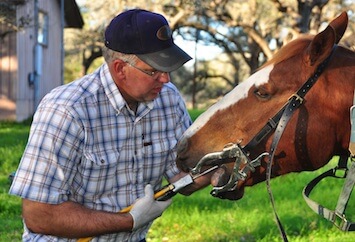Preventing Equine Dental Disorders

The natural diet of wild horses may have allowed their teeth to wear more evenly and effectively. Modern horses, however, typically enjoy softer forage that may be supplemented with grain or concentrated feed. This domestic diet may impact wear on the horse’s teeth. In addition, today’s companion horses live much longer than their wild counterpart, offering years of seniority in which to develop dental problems. Environment, diet, and longevity all contribute to the need for preventive dental care in horses.
Age & Chewing in Horses
The occusal or chewing surface of the molars gets smaller as the horse ages because the tooth diameter decreases as the teeth are worn away. As the tooth wears, so does the tooth enamel, and it becomes so smooth it cannot grind food at all. Due to these issues, it takes an older horse longer to chew feed than a younger horse. Dr. Warren considers the age and function of each patient when creating a dental plan. Aside from basic maintenance care, concerns at each stage of a horse’s life include the following:- Newborn foals—A visual and digital examination to check the foals bite.
- 1–2 year olds—By one year, 24–30 teeth have erupted. Baby teeth are soft and sharp edges may develop, causing ulcers or lacerations on cheeks and tongues. Wolf teeth are removed.
- 2–3.5 year olds—A large turnover of baby teeth to adult teeth occurs during this age range and any retained baby teeth may be removed to prevent problems.
- 4–5 year olds—New adult teeth may need sharp points smoothed. Geldings and stallions may have the four canine teeth breaking through the gum line during this age. All patients may require adjustments at this stage.
A note on canine teeth: By 6 years of age, the only teeth not fully erupted may be the canines in geldings and stallions, and sometimes mares. Canines may have sharp points that can be quite painful and may need smoothing.
- 6 year olds and up—All adult teeth are in position and in use. Regular maintenance care, including smoothing of sharp edges, minor rebalancing, and troubleshooting every 8–12 months is generally all that is required for normal mouths. Horses in competition and those with heightened sensitivity or pre-existing dental abnormalities may need more frequent dental care.
- Horses over the age of 16—Any tendency toward periodontal disease, fractured teeth, diseased roots, and loose teeth are addressed.
Any horse having regular, skilled dental care throughout life is less likely to develop significant problems in the senior years. Due to a horse’s superb coping mechanisms, by the time an owner suspects a possible dental problem, the issue may be quite severe. The ongoing comfort of every horse is dependent upon the owner’s willingness to provide consistent dental exams and subsequent care.
For a more in-depth discussion, Dr. Warren recommends Everything You Always Wanted to Know About Equine Dentistry by Mary DeLorey DVM, posted on the American Association of Equine Practitioners (AAEP) website.Possible Signs of an Equine Dental Problem
Your horse may demonstrate symptoms of a dental problem in various ways. Some common signs that point to a dental issue include:
- Dropping feed while eating
- Head turning, lifting, or thrusting into feed while eating
- Poor body weight or difficulty in maintaining weight
- Unprocessed feed in the stool
- Colic
- Fighting or chewing the bit
- Resisting being caught
- Bucking, rearing, pawing, or other behavioral issues
These are a few signs of a dental problem that may occur in your horse. However, equine dental needs vary. Maintaining a regular dental care program is the best way to avoid developing problems that cause your horse pain and difficulty in handling.
Learn about Dr. Warren’s methods and view photos of his step-by-step procedure for preventive equine dental care.
Oral Anatomy of a Horse
Adult horses have from 36–44 teeth, with six upper and lower incisors or front teeth. There are six upper and lower premolars and six upper and lower molars, sometimes called cheek teeth. Some horses may have wolf teeth or canine teeth, as well.
To better understand, take a look at the anatomy of a horse’s mouth